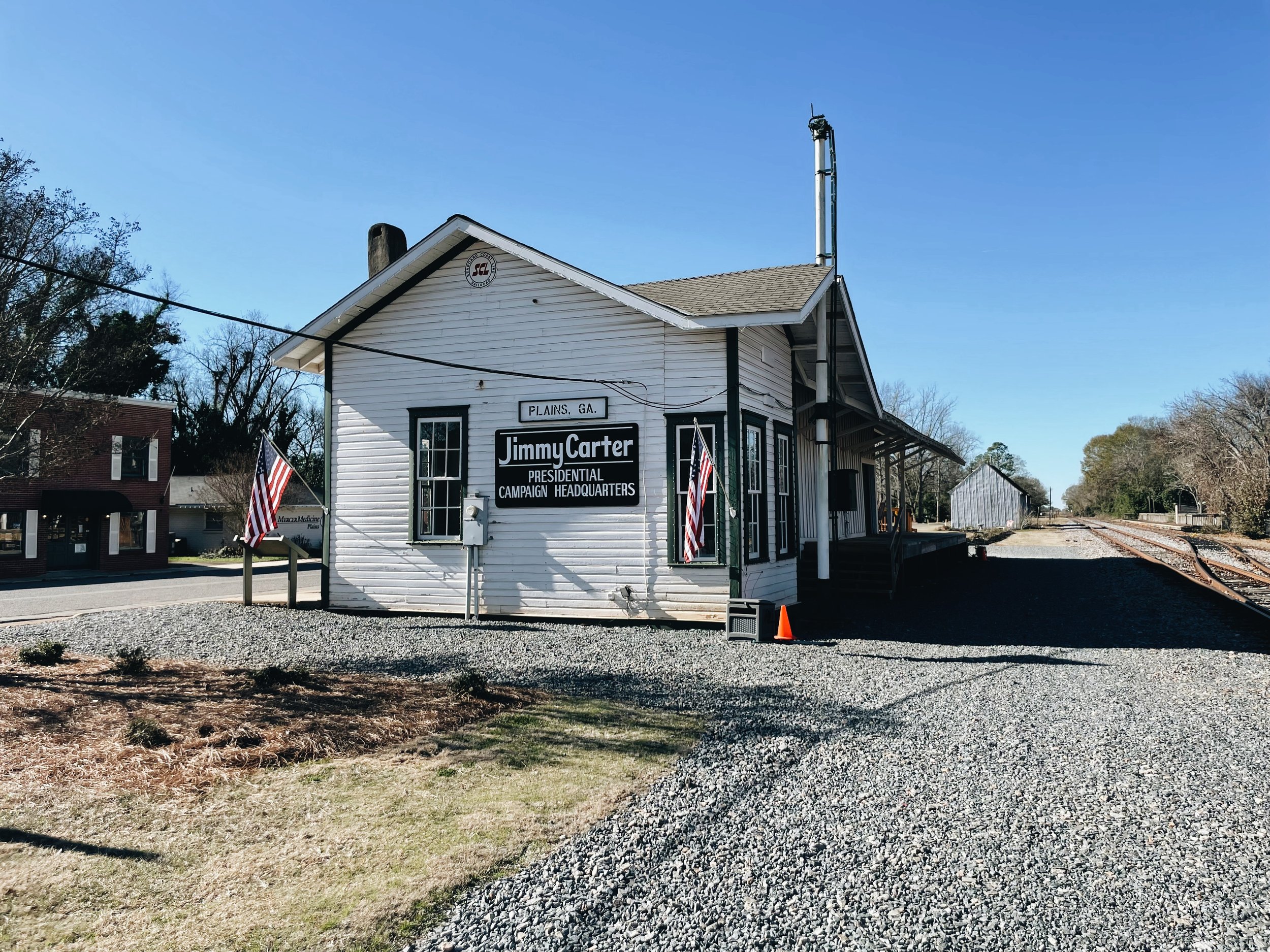Discovering Georgia's Past: Andersonville National Historic Site and Jimmy Carter National Historic Site.
Hi, Y’all. Growing up near Andersonville and Plains has given me a special bond with these places. Born and raised in Georgia, I’ve always been surrounded by Georgia’s Rich Historical Legacy. These sites, nestled in the heart of the state, offer a unique glimpse into America's past and present. Andersonville National Historic Site serves as a memorial to Civil War prisoners of war. At the same time, the Jimmy Carter National Historic Site celebrates the life and legacy of a beloved American president. Despite their contrasting narratives, these sites share a common thread of significance, drawing visitors from the darkest days of conflict to the hopeful promise of leadership and service.
Getting There: Navigating Your Journey to Andersonville and Plains
Driving down Interstate 75, these two sites are a short drive from the exit. Directions and Nearby Accommodations are easy to find, making your visit hassle-free. Exploring Americus: A Convenient Stay is a great option if you need to stay overnight. Americus, a nearby small town, offers a beautiful historic hotel, the Windsor Hotel.
Andersonville National Historic Site: A Sobering Civil War Remembrance.
Andersonville National Historic Site. Staging of camps inside the stockade. Photo by NPS.
The History of Andersonville Prison Camp is a somber tale of suffering and resilience. Andersonville National Historic Site in southwestern Georgia is a solemn reminder of the tragic American Civil War. Established on the grounds of the former Andersonville Confederate prison, the site commemorates the suffering endured by Union prisoners of war during their captivity from February 1864 to April 1865. Overcrowded and lacking essential resources, the camp became a crucible of suffering, resulting in nearly 13,000 deaths. Reflecting on the Lives of Civil War POWs is essential to understanding this dark chapter in American history.
Visiting the National Prisoner of War Museum provides an overview of the experiences of American POWs throughout history. Touring Andersonville National Cemetery allows visitors to pay respects to the Union soldiers who perished at the prison camp.
Activities at Andersonville National Historic Site.
Stockade markers at Andersonville National Historic Site
Exploring the Reconstructed Prison Grounds: Wander through the meticulously preserved grounds and see the reconstructed portions of the original prison site. Gain a sense of the conditions that the prisoners endured during their captivity.
Visit the National Prisoner of War Museum: This museum provides an overview of the experiences of American prisoners of war throughout history. Exhibits feature artifacts and personal POW stories that give insight into POWs' challenges.
Touring Andersonville National Cemetery: At the Andersonville National Cemetery, thousands of Union soldiers who perished at the prison camp are interred. The cemetery serves as a solemn reminder of the human cost of war.
Learning at the Visitor Center: Browse the visitor center's bookstore, where you can find books, maps, and souvenirs related to the history of Andersonville and the Civil War.
Discovering the Historic Village of Andersonville: Across the street is the village of Andersonville, which played a significant role during the Civil War. Here, the POWs set afoot from the train to their place at Camp Sumter.
Exploring Americus: The historic downtown area of Americus is nearby. Here, you can find local shops and landmarks, such as the Windsor Hotel, where you can stay the night.
Andersonville National Historic Site provides a deeper understanding of POWs and a reminder of their hardships. To learn more about the Andersonville National Historic Site, read our blog post: The History of the Civil War’s Andersonville National Historic Site.
Presidential Legacy: The Jimmy Carter National Historic Site in Plains, Georgia.
The Smiling Peanut. Built in 1976 to support President Carter’s campaign.
Tucked away in the charming small town of Plains, Georgia, the Jimmy Carter National Historic Site is a living tribute to one of America's most beloved leaders. This historic site commemorates the 39th President of the United States and provides visitors with an immersive experience of his personal and public life. From his humble beginnings to his rise to political prominence, this site offers a comprehensive look into the life of a man whose dedication to service and compassion left a lasting impact on our nation.
Jimmy Carter’s Early Years at Plains High School are well-documented at this historic site. Touring the Jimmy Carter Boyhood Farm offers a step back in time to the rural life that shaped President Carter’s early years. Insights from the Jimmy Carter National Historic Site Visitor Center provide a deeper understanding of his life and legacy. Exploring the Plains Depot and Billy Carter Service Station offers a unique glimpse into the 1976 presidential campaign and the life of Carter’s charismatic brother.
Activities at the Jimmy Carter National Historic Site.
This tiny little historic train stop served as the campaign headquarters for President Carter.
Strolling Through Historic Plains, Georgia: Take a leisurely walk through the picturesque town, visit local shops, dine in charming restaurants, and enjoy some peanut butter ice cream from a local shop.
Tasting Local Delights: Peanut Butter Ice Cream is a must-try in Plains.
Understanding President Carter’s Impact: The exhibits and personal artifacts at the visitor center highlight Carter’s achievements and challenges.
Visit Plains High School: Explore the school where Jimmy Carter and his wife Rosalynn both attended. The building has been restored to its 1927 appearance, providing a glimpse into its formative years.
Tour the Jimmy Carter Boyhood Farm: Step back at the farm where Jimmy Carter spent his early years. Walk through the farmhouse, barns, and surrounding fields to experience the rural life that shaped the future President.
Explore the Jimmy Carter National Historic Site Visitor Center. Through exhibits, photographs, and personal artifacts, you can Gain deeper insights into President Carter's life and legacy. Learn about his achievements, challenges, and the impact he made both nationally and globally.
Visit the Plains Depot: Explore the historic Plains Depot, central to President Carter's 1976 presidential campaign. The depot has been restored to its appearance during that significant period.
Discover the Billy Carter Service Station: Learn about Billy Carter, President Carter's colorful and charismatic brother, at the Billy Carter Service Station, preserved as it was during the late 1970s. My father used to play poker with Billy Carter at this very station.
Attend Church at Maranatha Baptist Church: Experience a Sunday service at the church where Jimmy Carter still occasionally teaches Sunday School. This unique opportunity offers a personal touch to the visit, allowing for a deeper connection to President Carter’s faith and community involvement.
Jimmy Carter National Historic Site provides a deeper understanding of the life and impact of one of America's most influential leaders. To learn more about the Jimmy Carter National Historic Site, read our blog post: Walk in the Footsteps of a President: Jimmy Carter National Historic Site.
Also, please check the official website for the latest information on operating hours and any special events or programs during your visit to Jimmy Carter National Historic Site.
Where to Stay: Accommodations in Americus, Georgia.
Stay the night in Americus, Georgia—where I grew up. Located conveniently between the Andersonville National Historic Site and the Jimmy Carter National Historic Site, Americus, Georgia, serves as the area's central hub. This charming Southern city is the perfect place to stay when visiting these historical landmarks. With its rich history, Victorian-era architecture, and warm Southern hospitality, Americus offers visitors a blend of cultural richness and small-town charm. The surrounding areas are more rural and lack extensive lodging options, making Americus the ideal base for explorations.
The Historic Windsor Hotel: A landmark in Americus, the Windsor Hotel is known for its elegant architecture and Southern charm. This historic hotel offers a unique blend of modern amenities and vintage ambiance, making it a popular choice for visitors seeking a luxurious stay with a touch of nostalgia.
Americus Garden Inn Bed and Breakfast: This lovely bed and breakfast offers guests a cozy and intimate atmosphere. Located in a historic home, it provides a warm and inviting retreat with beautifully decorated rooms and a delicious breakfast.
The Town House Inn: Although not in Americus, the Town House Inn is just a short drive away in Buena Vista, Georgia, at 108 Church Street. This beautiful 1903 architectural masterpiece of the Old South features the main house with three rooms and a guesthouse with four chambers. Owned by my old friend, Clay Snider, an interior decorator in Atlanta, the property features excellent, authentic, and timeless decor. You can make reservations by visiting their site.
Old Town House Inn in Buena Vista, Georgia. Photo from Old Town House Inn.
By staying in Americus or the nearby Town House Inn in Buena Vista, visitors can easily access both the Andersonville and Jimmy Carter National Historic Sites while enjoying the amenities and hospitality of this charming Southern region.
Local Dining in Americus: Southern Flavors and Hospitality.
Enjoying Italian Cuisine at Pat’s Place: Known for its pizzas, pasta dishes, and Italian cuisine.
Classic Hot Dogs at Monroe’s: An Americus institution for classic hot dogs.
Fine Dining at The Windsor Hotel: Offering Southern cuisine with a modern twist in a beautifully restored setting.
Conclusion: Embracing Georgia’s Historical and Cultural Richness.
The Importance of Andersonville and Jimmy Carter Sites cannot be overstated. These places, though different, have each shaped our country in unique ways. Experiencing Southern Hospitality is an added bonus, where strangers wave as you pass by. Encouraging Off-the-Beaten-Path Travel in Georgia reveals so much to see and learn within our country’s borders. It’s a good place to see and be, offering a rich blend of history and hospitality.





